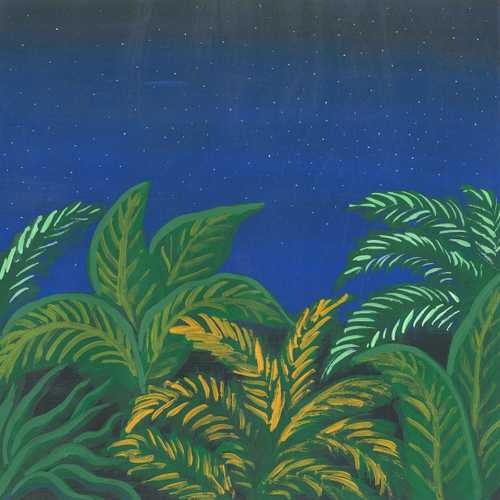
Biophilia defined, seagrass supported, and whale research disrupted | Newsletter #30
Jingiwallah*, friend. 🙋♂️
Just what is biophilia? What sound does a Hodgson’s frogmouth make? Do seagrasses have a role to play in resisting climate change? What are the arguments for integrating animals into the protective mandate of human rights? How has the Russo-Ukrainian War impacted scientific work in the Arctic?
Read on for answers.
*A greeting in the Yugambeh-Bundjalung language used by the Bundjalung people, on whose unceded land the soundscape below was recorded.
Soundscape of the week
The squeals, shrieks, and cackles of squabbling flying fox megabats may not sound appealing on paper, but in practice creates a wall of boisterous, raucous chiropteran white noise.
As generalists, flying foxes eat fruit, flowers, nectar, and leaves, meaning that they play an important role as seed dispersers and pollinators. They are primarily nocturnal but, unlike microbats, cannot echolocate, relying instead upon their sense of smell and eyesight, which is (understandably) keen in low light.
Any readers unconvinced about the charms of bats – or at least of fruit bats – are referred to exhibits A, B, and C.
Articles and essays
💚 The latest addition to the earth.fm Glossary summarizes the notion of biophilia – “the connections that human beings subconsciously seek with the rest of life” – from its origins to the ways that it has been explored and endorsed by findings in the fields of biological evolution and evolutionary psychology.
Bonus: the reason we find baby animals so damn cute.
⛰️ “Recorded in the cool montane forests of far north-west Thailand, this evening soundscape features the sounds of crickets and a gentle breeze blowing through oak and pine trees. A Hodgson’s frogmouth [a cousin of the nightjar] squawks occasionally in the distance. These forests support a range of species associated with the evergreen Himalayan foothills and are an oasis of life in an area where many of the surrounding areas have been cleared or significantly altered.”
Recorded by Marc Anderson in northern Thailand’s Doi Pha Hom Pok National Park, this episode of Wind Is the Original Radio, the earth.fm podcast, offers a sedate and calming soundscape of insects trilling against a backdrop of gentle wind.
Further episodes of the podcast are available on Apple and Google podcasts, Spotify, and Stitcher, with new installments featuring soundscape recordings released every Friday.

From the extended community
🌊 The New York Times reports on ‘A Powerful Climate Solution Just below the Ocean’s Surface’. Spoiler: it’s seagrasses. These “miracle machines” support “coastlines, break the force of hurtling waves, provide housing for fish, shellfish, and migrating birds, clean the water, store as much as 5 percent of the world’s carbon dioxide, and pump oxygen into the ocean”.
The article posits that “restoring seagrass is one tool that coastal communities can use to address climate change, both by capturing emissions and mitigating their effects”. Hearteningly, this is already happening in Virginia, USA, and parts of Britain and Western Australia. However (lest readers become too excited), “It’s estimated that a third of seagrass around the world has disappeared in the last few decades”. “Globally, a soccer field of seagrass is lost every 30 minutes”, due to “deoxygenation, ocean acidification and warming temperatures”, plus the effects of agricultural runoff and wastewater, and the resulting algal blooms which choke rival plants, then strip oxygen from the water when they die and decompose.
Nevertheless, Robert J Orth of the Virginia Institute of Marine Science has pioneered a process for collecting springtime seeds (with the help of hundreds of volunteers), which can then be planted in sediment during the autumn. Though it will be a slow process, which requires sustained community engagement, this work shows that seagrass meadows can be restored.
⚖️ Given that “the systematic subjugation, exploitation, and extermination of animals simultaneously contributes to some of the gravest social and environmental threats to human rights, such as animalistic dehumanization and climate change […] human and animal rights are best protected in concert”.
This is the premise of a new open-access book by Dr Saskia Stucki – précised in an article of the same name, ‘One Rights: Human and Animal Rights in the Anthropocene’, on the website of Harvard’s Animal Law & Policy Program – which seeks to illuminate this “traditional blind spot in human rights theory”.
🐋 ‘She Was on the Front Lines of Whale Conservation. Now She’s on the Front Lines of War’, a piece by investigative news organization Mother Jones, uses the example of Ukrainian whale conservationist Olga Shpak to explore the effect that the Russo-Ukrainian War is having on scientific investigations in the Arctic.
Shpak, whose research into Arctic and sub-Arctic marine mammals at Moscow’s A.N. Severtsov Institute of Ecology and Evolution “inspired some of Russia’s most significant whale conservation measures over the last decade”, currently considers herself a former scientist. Having left Russia prior to its invasion of her home country, she is now “working near the front lines of the war, helping nonprofit aid groups supply civilians and soldiers with everything from underwear and tourniquets to drones, wood-burning stoves, and pickup trucks”.
As part of the global temperature system, the warming of the Arctic – which is happening four times faster than anywhere else on the globe – threatens “not just the people, plants, and animals that live there—but also the rest of the planet”. “In short, there are few places on Earth more in need of scientists’ help than the Arctic. And the war has reduced their research to a trickle.”
👉 Follow us on Twitter for a daily dose of nature-sound inspiration!
How to support earth.fm
All 600+ of our curated, immersive soundscapes are free to listen to, but if you want to help us grow new forests, please become a supporter!
There are three options available, and you will also be able to favorite recordings, create and share playlists, and many other perks – plus a big surprise is coming exclusively to members in the next few weeks!
Until next time, we wish you a regenerative week. 🙏
With best wishes,
Neil and Team earth.fm
Reach out on hello@earth.fm 👋
Forward this newsletter to anyone who would appreciate it ✉️
Join the conversation with the Earth.fm community 🤝
Submit a recording 🎤
Follow us on Twitter. Instagram and YouTube 💻
Listen to nature sounds in your browser by installing our free extension 🎧
Earth.fm is a completely free streaming service of 1000+ nature sounds from around the world, offering natural soundscapes and guided meditations for people who wish to listen to nature, relax, and become more connected. Launched in 2022, Earth.fm is a non-profit and a 1% for the Planet Environmental Partner.
Check out our recordings of nature ambience from sound recordists and artists spanning the globe, our thematic playlists of immersive soundscapes and our Wind Is the Original Radio podcast.
You can join the Earth.fm family by signing up for our newsletter of weekly inspiration for your precious ears, or become a member to enjoy the extra Earth.fm features and goodies and support us on our mission.
Subscription fees contribute to growing our library of authentic nature sounds, research into topics like noise pollution and the connection between nature and mental wellbeing, as well as funding grants that support emerging nature sound recordists from underprivileged communities.

